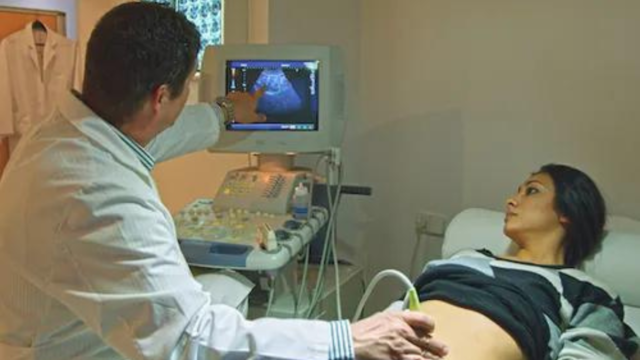
UTSW
Patricia Santiago-Munoz,
M.D.Obstetrics and Gynecology
Approximately one-third of all babies in the U.S. are delivered by C-section, and as those rates increase so has the possibility of a rare but serious complication called cesarean scar ectopic pregnancy (CSEP).
In a CSEP, an embryo attaches to the scar tissue left from a previous C-section instead of attaching to the wall of the uterus, where a healthy pregnancy can grow. The scar tissue is not as strong as the uterine wall and can tear and may result in hemorrhage. The placenta will grow in the wrong place, causing bleeding and potentially leading to a hysterectomy, damage to surrounding organs, or death of the pregnant patient.
The most common ectopic pregnancies attach to the fallopian tubes with no chance of viability, which means the pregnancy will never lead to a liveborn baby. In most cases, CSEP pregnancy is not viable, either – the embryo does not develop a heartbeat or cannot safely grow and must be medically or surgically removed.
However, in those rare cases when the embryo has a heartbeat, the pregnant patient must make a difficult decision. She can choose to end the pregnancy and avoid serious, potentially fatal complications. Or she can continue with the pregnancy, accepting the serious risks to the pregnancy and her life, which can include:
- Heavy internal bleeding (hemorrhage)
- Preterm delivery
- Ruptured uterus, which can be fatal and requires hysterectomy
- Placenta accreta, when the placenta grows too deeply into the uterine wall and can cause heavy bleeding during and after delivery
- Placenta percreta, when the placenta grows through the uterus and potentially attaches to nearby organs such as the bladder or bowel, resulting in surgery to remove a portion of the affected organs
The Society for Maternal-Fetal Medicine (SMFM) recommends against continuing a CSEP due to risks of morbidity and mortality to the patient. Treatments for miscarriages and ectopic pregnancies such as CSEP are legal under Texas’ abortion law. Your UT Southwestern care team will respect your decision and counsel you about your options and next steps if you are diagnosed with CSEP. Most importantly, if you are experiencing bleeding or pregnancy complications, seek medical care right away.
Diagnosing CSEP
CSEP occurs in approximately 1 in 1,800 to 1 in 2,600 pregnancies. Even as a designated Level 4 maternal health center, the highest maternal care designation in the state, UT Southwestern specialists see fewer than five cases each year.
Often there are no symptoms of CSEP until complications occur – unlike a typical ectopic pregnancy, about a third of CSEP patients will not experience cramping or spotting early in pregnancy.
If you’ve had a prior C-section and are pregnant, it is best to have an ultrasound within eight weeks after a positive pregnancy test to determine whether you have a healthy pregnancy. To potentially identify or rule out CSEP, the provider will look for one or more of these specific criteria on your ultrasound:
- Absence of fetal cardiac activity
- Empty uterus or cervix
- Placenta, amniotic sac, or both embedded in the C-section scar tissue
- Rich blood vessels or blood flow at or in the scar tissue
- Thin or absent layer of tissue between the amniotic sac and bladder
- Triangular or oval amniotic sac, suggesting it is pressed into the unusual space of the scar tissue (it should be rounded)
Presence of one of these criteria does not automatically indicate a CSEP, and sometimes imaging can be inconclusive. Further testing or imaging can help guide the diagnosis and provide you information to decide on treatment or next steps.
Related reading: Why you should ask about your hospital’s C-section rate
Treatment options to remove a CSEP
The least invasive treatment to end a CSEP is an injection of medication into the amniotic sac to stop embryonic cardiac activity, if present. Then, your provider will offer either observation until miscarriage occurs (which could take several weeks) or surgery.
Patients with CSEPs implanted deeply or in a complicated location may need ultrasound-guided surgery to remove embryonic tissue through the vagina. Patients who want to try for a future pregnancy may need laparoscopic surgery to remove the embryo and part of the scar tissue. During this procedure, the surgeon may revise the scar tissue to create a smoother surface that may be less problematic in the case of future implantation in that area.
Patients who choose to continue a CSEP remain at high risk of placenta accreta and if that were the case, would need preterm delivery by C-section. A maternal-fetal medical doctor who specializes in high-risk pregnancy care will monitor your pregnancy and delivery.
It is rare for a patient who has a CSEP delivery to keep their uterus. In most cases, hysterectomy is performed at the same time as the C-section. We counsel patients to plan for this procedure, though we will work to preserve the uterus if possible.
CSEP is not caused by anything a patient has done. You can’t prevent or reduce the risk.
If you’ve had a prior C-section, contact your doctor as soon as you find out you are pregnant to schedule an early first trimester ultrasound, ideally by 8 weeks. If CSEP is identified, a high-risk pregnancy specialist will discuss your options to help you make the best decision for your health and, if desired, your future fertility.
To talk with an Ob/Gyn specialist call 214-645-8300 or request an appointment online.









